Imagine a vibrant, resilient bloom emerging from the heart of the arid desert. Its delicate petals unfurl to reveal a mesmerizing shade of pink. These captivating pink cactus flowers show the incredible adaptability and beauty of desert flora.
As a passionate gardener, I’ve been enchanted by these hardy succulents for years. I’m thrilled to share my knowledge to help you cultivate your own slice of desert paradise.
Whether you’re drawn to the allure of desert flora or seeking to add a touch of the exotic to your space, pink cactus blossoms offer a unique and rewarding gardening experience. They have stunning displays and play a crucial role in desert ecosystems. These remarkable plants teach us about the resilience and beauty of the natural world.
Introduction to Pink Cactus Flowers
Pink cactus flowers are vibrant and stunning. They come from various cactus species, like the prickly pear and desert rose. These flowers are shaped like trumpets and can grow up to 3 inches wide. They have five petals that form a star-like pattern.
These flowers are key to desert ecosystems. They offer food and shelter to many animals. This makes them vital to the desert’s balance.
What Are Pink Cactus Flowers?
Pink cactus flowers are the colorful blooms of cacti. These plants are known for living in dry, harsh environments. The flowers can be soft pastel colors or bright fuchsia, catching the eye with their beauty.
They are adapted to survive in dry conditions. The prickly pear bloom and other succulent flower types show how desert plants can thrive.
Importance in Ecosystems
Pink cactus flowers are crucial to desert ecosystems. They feed pollinators like hummingbirds, bees, and butterflies. These pollinators help cacti reproduce and spread.
The flowers also offer shelter and nesting materials for small animals. This helps keep the desert diverse and resilient.
| Cactus Species | Bloom Color | Bloom Size | Bloom Season |
|---|---|---|---|
| Prickly Pear (Opuntia) | Pink, Fuchsia, Yellow | 2-4 inches | Spring, Summer |
| Barrel Cactus (Ferocactus) | Pink, Red, Yellow | 1-2 inches | Summer |
| Christmas Cactus (Schlumbergera) | Pink, White, Lavender | 2-3 inches | Winter, Spring |
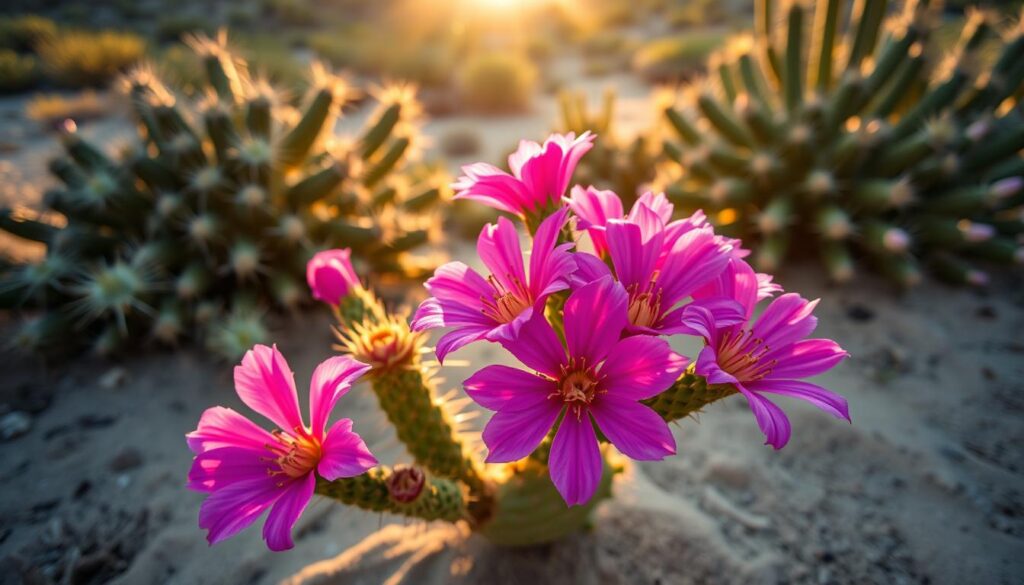
The prickly pear bloom and other succulent flower types are amazing. They show the strength and adaptability of desert plants. These flowers are not just beautiful; they also help keep the desert ecosystem healthy.
Types of Pink Cactus Flowers
In the southwestern United States, pink cactus-flowers bloom in the desert. You’ll see everything from the iconic Opuntia (Prickly Pear) to the delicate Echinocereus (Hedgehog Cactus). These plants show the wide range of beauty in the cactus family.
Popular Varieties
The Desert Rose, or Adenium obesum, is a favorite. It has a swollen trunk, waxy leaves, and pink flowers up to 7 inches long. The Opuntia, or Prickly Pear, is also loved. It has flat stems with bright pink Opuntia blooms.
The Echinocereus, or Hedgehog Cactus, is another beauty. These small cacti have pink flowers that cover the plant. They create a stunning display of southwestern botany.
“The diversity of pink cactus-flowers is a testament to the resilience and beauty of the cactus family in the Southwest.”
Unique Characteristics
Pink cactus-flowers have special features for desert life. Their thick stems store water, helping them survive dry conditions. The sharp spines protect them from animals and harsh weather.
These flowers come in different sizes, shapes, and shades of pink. From the Desert Rose’s bold blooms to the Hedgehog Cactus’s delicate flowers, each adds to the southwestern botany beauty.
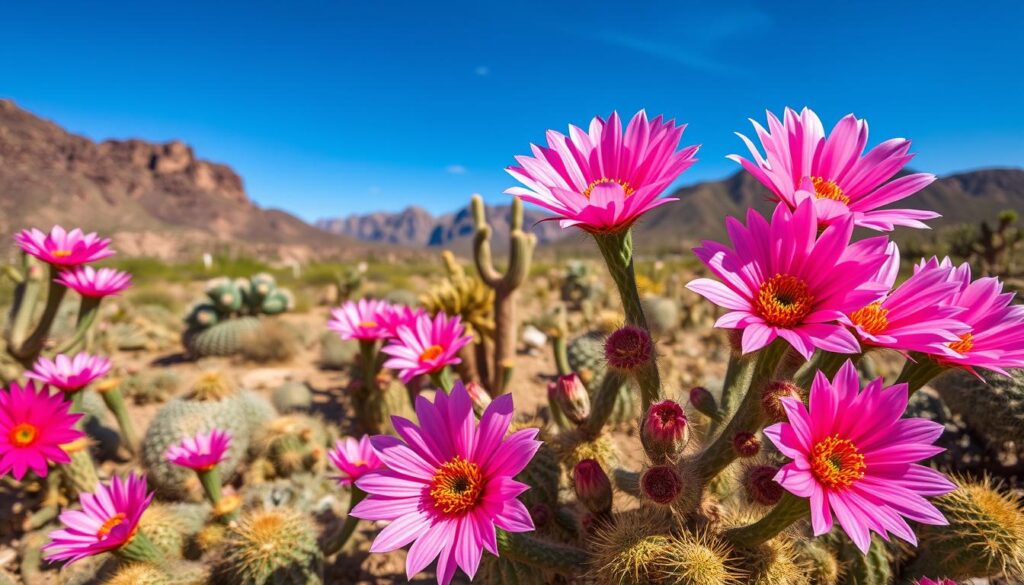
Growing Pink Cactus Flowers at Home
Bringing pink cactus-flowers into your home garden is rewarding. To make them thrive, you need the right conditions, soil, and care. With some knowledge, you can grow stunning pink cactus-flowers that add a Southwest touch to your garden.
Ideal Growing Conditions
Pink cactus-flowers need lots of sunlight. Place them in a spot that gets 6 to 8 hours of direct sun. Keep the temperature between 70-100°F to match their desert home.
Soil and Water Requirements
They need well-draining soil to grow well. Use a cactus mix or make your own with sandy loam, perlite, and small gravel. Water them a bit during warm months, letting the soil dry out between waterings. In cooler times, water less to avoid root rot.
Fertilization Tips
Lightly fertilize your pink cactus-flowers when they’re growing. Use a balanced 5-10-5 NPK fertilizer every 4-6 weeks. Don’t overdo it, as too much fertilizer can harm their growth and blooms.
With the right conditions, soil, and fertilization, your pink cactus flower garden will thrive. It will be a beautiful desert-inspired addition to your outdoor space.
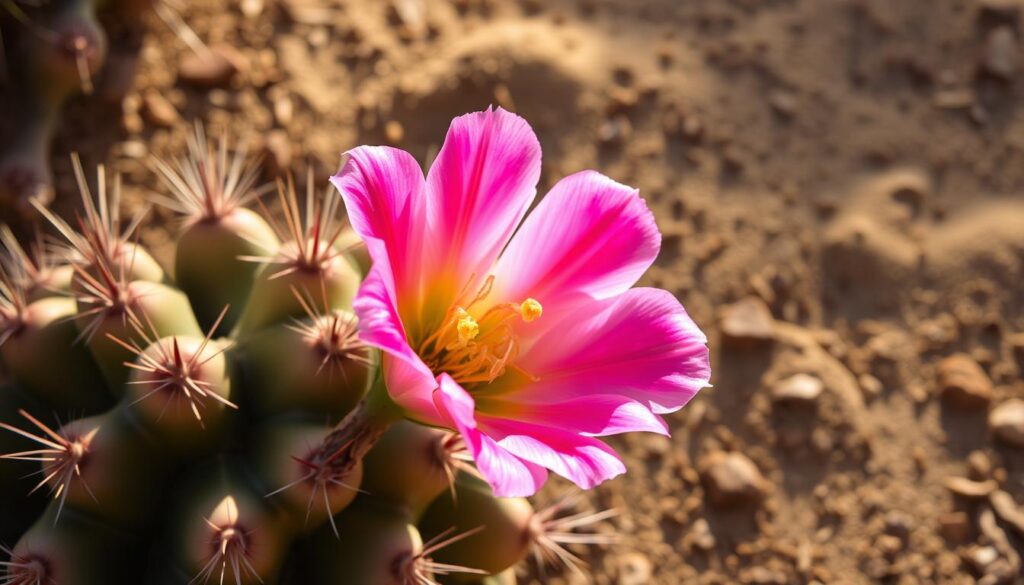
Caring for Pink Cactus Flowers
Keeping pink cactus-flowers looking their best requires careful attention. These plants may seem tough, but they need specific care to flourish. We’ll look at common pests and diseases and share tips on pruning to keep them healthy.
Common Pests and Diseases
Pink cactus-flowers can face a few common enemies. Mealybugs, scale insects, and spider mites often target them. Also, too much water can cause root rot, a fungal disease. To avoid these problems, water correctly and check your plants often for signs of trouble.
How to Prune Successfully
Pruning is key to keeping your pink cactus-flowers looking great. Use sharp, clean tools to cut off dead or damaged parts. This helps the plant look better and grow more blooms. Always wear gloves when pruning to protect against the cactus’s spines.
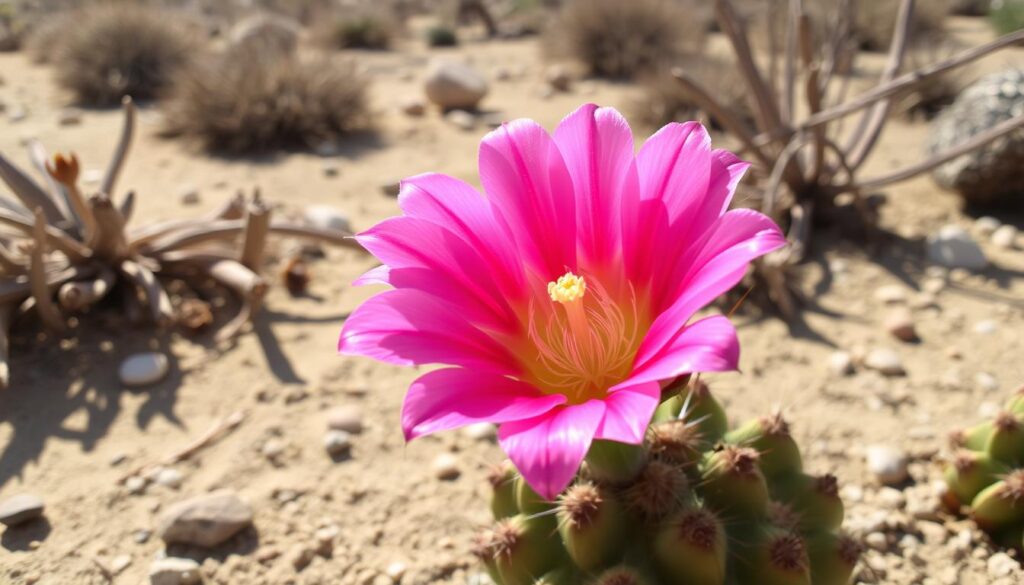
Knowing how to care for pink cactus-flowers can make them a lasting beauty in your space. With the right care and attention, they will continue to amaze and add desert charm to your home or garden.
The Role of Pollinators
In the southwestern desert, desert flora and cactus blossoms need pollinators to reproduce and stay diverse. Bees and butterflies are key to this, playing a vital role in southwestern botany.
Importance of Bees and Butterflies
Bees and butterflies love the colors and sweet nectar of cactus blossoms. They move pollen from flower to flower, helping plants to seed and grow. Without them, the desert flora would find it hard to survive and keep the ecosystem in balance.
Tips for Attracting Pollinators
- Plant a variety of native flowers with your cactus blossoms to offer more nectar for pollinators.
- Make sure there are shallow water sources, like birdbaths, for bees and butterflies to drink from.
- Don’t use pesticides, as they harm pollinators and upset the natural balance of southwestern botany.
By making your space friendly to pollinators, you boost your cactus blossoms and help the local ecosystem stay healthy and strong.
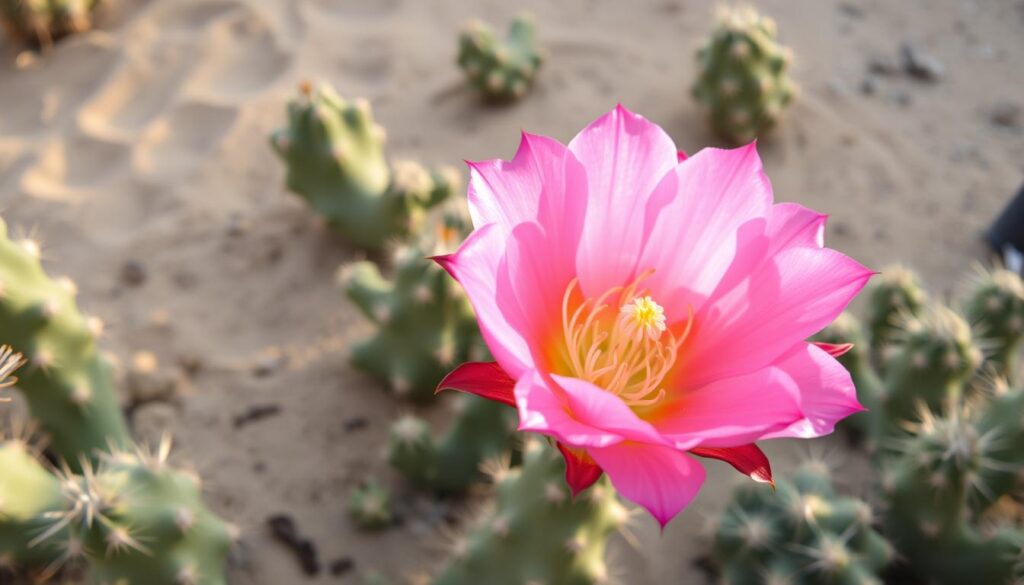
“The decline of pollinators is a global crisis, and we all have a role to play in reversing this trend. By supporting our local desert flora and its pollinators, we can help ensure the continued flourishing of these remarkable southwestern botany species.”
Seasonal Changes and Pink Cactus Flowers
As the seasons change, the prickly pear bloom and Opuntia bloom of pink cactus-flowers change the desert. These spiny floral wonders bloom most in spring. They show off their bright colors and soft petals then.
Spring Blooming Period
When it gets warmer and days get longer, pink cactus-flowers start to bloom. They color the dry land with their bright colors. It’s important to give them enough water and sunlight during this time.
Summer Care Tips
- Protect plants from intense summer heat by offering partial shade if necessary.
- Reduce watering frequency during the hottest months to prevent issues like root rot.
- Adjust your care routine to ensure the plants remain healthy and continue to produce their prickly pear bloom and Opuntia bloom throughout the year.
By paying attention to the seasons and adjusting your care, you can enjoy pink cactus-flowers all year. From spring’s first blooms to summer’s last spiny floral shows.
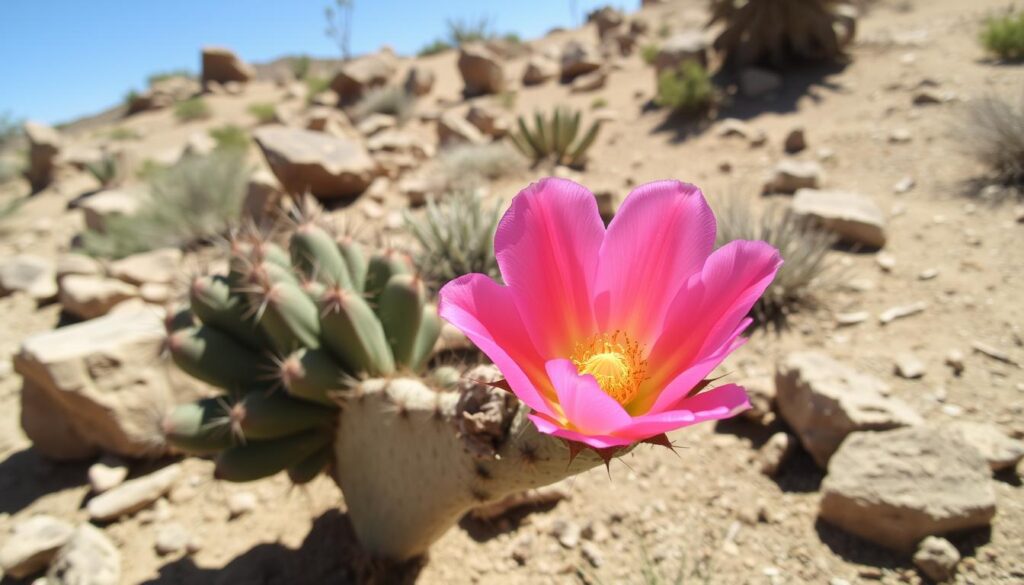
Uses of Pink Cactus Flowers
Pink-cactus-flowers are more than just pretty. They have vibrant colors and unique textures. These succulent blooms are great for decoration and cooking, bringing desert charm to any place.
Decorative Purposes
Pink cactus-flowers are perfect for gardens, rock gardens, and homes. Their bright, pinkish-red color stands out against green or grey plants. You can use their petals and pads in flower arrangements, adding elegance to any bouquet or centerpiece.
Culinary Uses
Some pink cactus-flowers, like those from the prickly pear cactus, are edible. You can use their fruits and pads in food. The flowers themselves can garnish dishes or add flavor to salads. But, make sure to identify and prepare them safely, as some cacti can be toxic.
| Decorative Uses | Culinary Uses |
|---|---|
|
|
Pink cactus flowers are versatile, appealing to gardeners, flower lovers, and food explorers. By learning about their uses, you can bring natural beauty and flavor into your life.
Cultural Significance of Pink Cactus Flowers
Pink cactus-flowers are very important in many cultures, especially in the American Southwest and Mexico. They symbolize endurance, protection, and adaptability. This shows how cacti can survive in very dry places. The value of desert flora, southwestern botany, and arid plant life is tied to the area’s rich history and traditions.
Symbolism in Different Cultures
In Native American cultures, cacti and their flowers are key in art, ceremonies, and spiritual beliefs. They are admired for surviving in tough conditions. This shows the spirit of resilience and overcoming challenges. The pink cactus flower is seen as a symbol of beauty, strength, and balance between fragility and toughness.
Pink Cactus Flowers in Art and Literature
The beauty of pink cactus-flowers has inspired many artists and writers. Georgia O’Keeffe’s paintings and Willa Cather’s writings are famous examples. They show the beauty and cultural heritage of the region.
“The desert flowers, finding their way through the rocks, are a symbol of tenacity and an expression of the unquenchable life force.”
– Willa Cather, American author
Today, the pink cactus-flower still inspires artists and writers. It represents the enduring spirit and resilience of southwestern botany. This has fascinated people for centuries.
Challenges in Cultivating Pink Cactus Flowers
Growing cactus family bloom, spiny floral, and succulent flower species is rewarding but challenging. To grow pink cactus-flowers, you need to balance environmental conditions and care. Let’s look at the main challenges and how to solve them.
Climate Considerations
Ensuring the right climate is a big challenge. These spiny floral plants love warm, dry places. But, it’s hard to create these conditions in places they’re not native to. You need to provide enough sunlight, manage soil moisture, and protect from frost.
In cold places, growing pink cactus-flowers in pots that can move inside in winter helps. This keeps the succulent flower warm and safe to bloom.
Overcoming Common Obstacles
Overwatering is a big problem that can kill cactus family bloom plants. To prevent this, use soil that drains well and adjust when you water based on the season. Cut back on water during the plant’s dormant time to keep it healthy.
Pests and diseases are also challenges. Watch your plants closely and use natural pest control or beneficial insects to fight these issues. This keeps your spiny floral plants healthy and blooming.
With the right knowledge, patience, and effort, growing these unique succulent flower species is rewarding. Understanding their needs and using smart care methods can help even beginners enjoy their beauty. These desert plants add vibrant colors and stunning looks to any garden.
Conclusion: Embracing Pink Cactus Flower Beauty
The pink cactus flowers are a mix of beauty, toughness, and flexibility. They add color to dry places and grow well in different spots with the right care. Knowing how to care for them lets gardeners and plant lovers enjoy these beautiful cactus blossoms.
By loving pink cactus flowers, we make our gardens and homes more interesting. We also learn to value the wide range of desert plants. These plants are strong, clean the air, and need little care.
Whether you love their pretty flowers or the cactus’s shape, adding pink cactus flowers to your space is rewarding. It lets us enjoy and celebrate the amazing beauty of nature.
FAQ
What are pink cactus-flowers?
Pink cactus-flowers are the bright blooms of various cactus types. This includes the popular prickly pear and desert rose. These flowers have a trumpet shape with five petals, reaching up to 3 inches wide.
Why are pink cactus-flowers important in desert ecosystems?
Pink cactus-flowers are key in desert ecosystems. They offer food and shelter for bees and butterflies. Their strong scent helps them survive in dry environments.
What are some popular varieties of pink cactus-flowers?
Adenium obesum (Desert Rose), Opuntia (Prickly Pear), and Echinocereus (Hedgehog Cactus) are popular. These plants have thick stems for water, spines for protection, and bright pink flowers.
How do you grow pink cactus-flowers at home?
To grow pink cactus-flowers at home, give them full sun and temperatures between 70-100°F. Use a cactus mix for soil and water moderately in warm months. Water less in cooler seasons. Fertilize lightly with a balanced fertilizer to encourage blooms.
What common pests and diseases affect pink cactus-flowers?
Mealybugs, scale insects, and spider mites can harm pink cactus-flowers. Root rot from too much water is another issue. Keep plants dry and check them often to prevent these problems.
How do pollinators interact with pink cactus-flowers?
Bees and butterflies are vital for pink cactus-flowers. They help the plants reproduce and keep their genetic diversity. To attract them, plant native flowers, provide shallow water, and avoid pesticides.
When do pink cactus-flowers typically bloom?
Pink cactus-flowers bloom in early spring and sometimes in autumn. In spring, ensure they get enough water and sunlight. In summer, protect them from too much heat with shade if needed.
What are the uses of pink cactus-flowers?
Pink cactus-flowers are used for decoration and in cooking. They add color and texture to gardens and indoor spaces. Some varieties, like prickly pear, have edible fruits and pads. The flowers can also be used as garnishes or in salads.
What is the cultural significance of pink cactus-flowers?
Pink cactus-flowers have deep cultural meaning in the American Southwest and Mexico. They symbolize endurance, protection, and adaptability. In art and literature, they represent desert beauty and resilience.
What are the challenges in cultivating pink cactus-flowers?
Growing pink cactus-flowers can be tough, especially outside their native areas. Challenges include getting enough sunlight, keeping the soil right, and protecting from frost. Overwatering can cause root rot. Use the right soil, ensure good drainage, and adjust watering with the seasons.


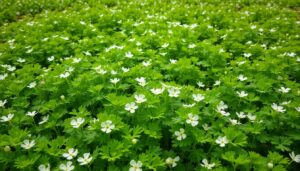








1 thought on “Pink Cactus Flower: Nature’s Desert Beauty Guide”